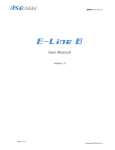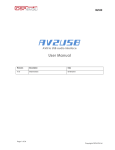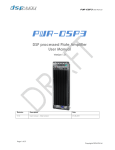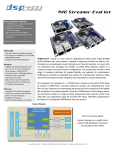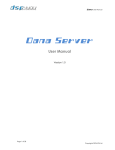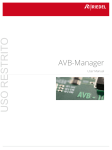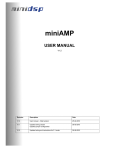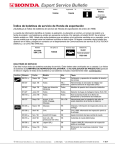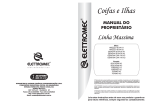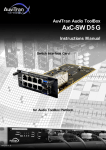Download DSP4YOU AVB Outputs User manual
Transcript
EPower User Manual E-Power User Manual Version 1.0 Page 1 of 15 Copyrights DSP4YOU ltd EPower User Manual Description Configurable as 2x20W in Bridge Tied Load (BTL) or 4x10W in Single Ended (SE) mode, E-Power fits the requirements of both commercial A/V and I.T. installations. Hardware isn't the only innovative element of this product. From network redundancy to our innovative auto-discovery protocol, E-Power provides un-paralleled level of abstraction to get audio up and running. With our ZeroConf automatic configuration and hostname labeling of devices, setup of an ELine system is really only a drag & drop away. Finally, aside from being a Plug&Play AVB-ready interface, E-power also answers the needs for small & low power Digital Signal Processing (DSP). With our proven plug-in technology, DSP4YOU’s platform delivers flexibility without the headaches of learning to program a new DSP platform. With the ability to upgrade plug-ins over the network, Epower will evolve over time to better fit your client’s needs. Hardware o 400MHz quad-core processor o Configurable as 2x20W or 4x10W o 100Base-T Ethernet o Redundant Ethernet connector o Power-over-Ethernet (PoE) Firmware o ZeroConf setup o Self discovery of device o DHCP or Link Local addressing o Plug&Play configuration o Remote firmware upgrade over network On-Board DSP o 28/56bit fixed point DSP o 48kHz sample rate o Enabled based on the selected Plug-in (DSP configuration) o Metering, Automatic Gain Control, Parametric equalizers, Compressor/Limiter, delay, phase, gain System Diagram Page 2 of 15 Copyrights DSP4YOU ltd EPower User Manual Table of Content 1 Product Overview......................................................................................................................................................................4 1.1 Front Panel Description...................................................................................................................................................4 1.2 Rear panel description ...................................................................................................................................................4 1.3 Feature description .........................................................................................................................................................4 1.3.1 Audio Video Bridging ...............................................................................................................................................4 1.3.2 Digital Signal Processing ..........................................................................................................................................5 1.3.3 Power over Ethernet (PoE)...................................................................................... Error! Bookmark not defined. 2 Setup guide ................................................................................................................................................................................5 2.1 E-power Box content ......................................................................................................................................................5 2.2 Connectivity.....................................................................................................................................................................6 2.2.1 Network ......................................................................................................................................................................6 2.2.2 Analog audio connectivity .....................................................................................................................................6 2.2.3 DC power connectivity............................................................................................................................................7 2.3 System setup requirements............................................................................................................................................7 2.3.1 PC systems .................................................................................................................................................................7 2.3.2 Configuration from a Dana server .........................................................................................................................7 2.4 AVB Streamer Tools setup guide ...................................................................................................................................7 3 System Configuration................................................................................................................................................................8 3.1 User interface overview of the AVB Streamer toolbox..............................................................................................8 3.2 E-power configuration....................................................................................................................................................8 3.2.1 Device info page......................................................................................................................................................8 3.2.2 Audio Video Bridging (AVB) stream configuration..............................................................................................9 3.2.3 Audio settings ..........................................................................................................................................................12 4 Technical specifications .........................................................................................................................................................14 4.1 E-power Technical specifications ...............................................................................................................................14 4.2 Mechanical drawings...................................................................................................................................................15 Page 3 of 15 Copyrights DSP4YOU ltd EPower User Manual 1 1.1 Product Overview Front Panel Description 1 1. Network connection #1 & 2 on RJ45 connector. Connect to your Ethernet network. 1.2 Rear panel description 1 2 1. Amplified outputs on Phoenix style Plug-in terminal. 2. DC input for device powering. Requires a stable +18VDC supply. 1.3 1.3.1 Feature description Audio Video Bridging AVB defines a group of network protocols for the distribution of time synchronized and low latency Audio & Video streams over IEEE802 networks. By leveraging a combination of existing 802 network technologies along with standards specifically designed for the purpose, AVB technology lays the ground work for un-paralleled guaranteed media streaming over Ethernet networks. The overall concept of AVB is actually rather simple. Without getting into too much detail, the three core protocols specify: Timing and synchronization Bandwidth allocation through the Stream Reservation Protocol (SRP) Traffic shaping to ensure that low priority Ethernet traffic does not interfere with AVB traffic Engineered from the ground up for media streaming applications, AVB has a definitive edge over legacy Ethernet technology in the sense that it allows bandwidth allocation and priority rules based on timing. Unlike similar audio over IP (AOIP) technology, AVB will dynamically assign and defend bandwidth allocation for AVB streaming thanks to the concept of Stream Reservation Protocol (SRP). Terminology for AVB streaming goes as follow: o Audio Video Bridging (AVB): General descriptive for a group of protocols providing audio/ video streaming, timing, synchronization, Quality of service (QoS) , control and discovery. o AVB Endpoint: AVB powered device, capable of transmitting and/ or receiving audio streams using P1722/ P1733 transport protocol. o Talker: AVB endpoint transmitting audio to the network. (Source) Page 4 of 15 Copyrights DSP4YOU ltd EPower User Manual o o o o o 1.3.2 Listener: AVB endpoint receiving audio from the network. (Sink/ Destination) Talker/Listener: AVB endpoint that is both transmitting and receiving. All AVB endpoints used on Dana series are by default Talker/Listener devices. Precision Time Protocol (PTP): Allows devices on the network to get a notion of global time in the effort to synchronize with each other. PTP component in each AVB module can act as a Grand Master (providing clock) or as a slave (receiving clock). Once a grand master negotiates and is selected as a sync source, all units will synchronize to it. Streams: General term describing packetization of one or multiple audio/ video channels over the network. Stream can be unicast or multicast. For the time being, the AVB module only supports unicast streaming. Future revisions will provide additional features. Stream ID: Unique 64-bit stream identifier used by AVB transport protocols to identify streams. Digital Signal Processing E-power is fitted with a small fixed point Digital Signal Processor (DSP) providing basic filtering tasks such as gain control, signal metering, Low/High pass filtering, parametric equalization and dynamic range control (Comp/limiter). A basic fixed processing audio flow is shown as below: 2 2.1 Setup guide E-Power Box content Box Content E-Power module in steel enclosure Removable wall mount ears Step-by-step startup guide Phoenix style terminal plug-in terminal blocks Mounting instructions The E-Power unit ships with removable ears allowing wall/ceiling mount installation. Remove the 4 x M3 screws to modify the configuration of your unit. The following drawing illustrates the dimension of the box and keyhole locations. Page 5 of 15 Copyrights DSP4YOU ltd EPower User Manual 2.2 2.2.1 Connectivity Network E-power requires at least one Ethernet connection for configuration and audio streaming. Configuration is performed using the provided AVBStreamer toolbox software and using a single Ethernet cable. • A standard-straight through Ethernet CAT5/6 network is required for connectivity through a network switch. • A crossover CAT-5/6 cable is required for direct connectivity to a PC/Mac machine that doesn’t support auto-switching. E-power devices utilize “Zeroconf” technology for plug&play integration. If a DHCP server is present at boot up, the E-power will automatically acquire an IP address If no DHCP server is present at boot up, the E-power will use the Link Local Address (Auto IP) P 169.254.0.xxx Network requirements: • Audio Video Bridging systems requires special AVB enabled network switches ( so called AVB bridge) to enjoy the advanced features of AVB such as the Stream Reservation Protocol. Such AVB bridge will have the capability to shape the traffic of the network such that any AVB traffic has higher priority. If in doubt, don’t hesitate to contact our technical support team at [email protected] 2.2.2 Analog audio connectivity E-power can operate in 2 modes of operation: - Single Ended mode(SE): 4 x 10W of amplification. This mode is the Factory default - Bridge Tied Load mode (BTL): 2 x 20W of amplification The toggling from one mode to the other is made using internal jumpers. Please open the box by removing the 2 front panel screws. 4 x 10W (Single Ended) – FACTORY DEFAULT - CH1 + - + CH2 - + CH3 - - + CH4 Internal Jumpers CH1 - + CH2 Jumpers in Top side of the board - + - + CH3 Internal Jumpers - + - + - CH4 Power Down Mute Gain1 Gain0 Config2 Config1 + - + Jumpers in Top side of the board Power Down Mute Gain1 Gain0 Config2 Config1 + 2x20W (BTL) Page 6 of 15 Copyrights DSP4YOU ltd EPower User Manual 2.2.3 DC power connectivity E-power requires an external DC supply with +18VDC and at least 45W total power to insure all channels 2.3 2.3.1 System setup requirements PC systems In the event of E-power being part of a system without a Dana server, the device requires an initial configuration to operate correctly. A windows PC environment requires the following specs: CPU 1GHz or higher 128MB video card 1 x 10/100MB network connection Latest version of Adobe Flash web plug-in from Adobe.com website : http://get.adobe.com/flashplayer/ Latest version of the Adobe Air environment from Adobe Website: http://get.adobe.com/air/ Keyboard & Mouse 2.3.2 Configuration from a Dana server The following software installation is only required for system configuration without a Dana Server. If the Epower is part of a system involving at least one Dana server, all AVB endpoints will be available for configuration from the device tree in the Dana Server Web Interface. Please refer to section 3.0 for more information about configuration steps. 2.4 AVB Streamer Tools setup guide The AVB Streamer tool is an Air application based on the Adobe Air environment running on a PC. It has the following system requirements: Software Microsoft• ® Windows® Vista® SP1/ XP pro SP2 Microsoft• ® .NET framework v3.5 Adobe AIR environment Hardware PC with 1GHz or higher processor clock speed recommended / Intel® Pentium®/Celeron® family, or AMD K6®/AMD Athlon®/AMD Duron® family, or compatible processor recommended. 256 megabytes (MB) of RAM or higher recommended USB 2.0 port Keyboard and mouse or compatible pointing device Step1: Pre-installation steps Install .net framework and .Air environment on your PC. Step2: Getting AVBStreamer Tools install package Get the latest version of AVBStreamer tools from www.dsp4you.com. Login with your user account to gain access to the secure section of the website. Step3: Installation Launch AVBStreamer Toolbox.exe Page 7 of 15 Copyrights DSP4YOU ltd EPower User Manual Following a successful installation, AVBStreamer tools will be automatically launched and discover modules on the network. See the default startup screen below. AVB Device Tree lists devices discovered on the network & Virtual devices 3 System Configuration 3.1 User interface overview of the AVB Streamer toolbox E-power configuration software provides a simple user interface for configuration of the AVB and DSP setting of Epower currently connected on the network. Note that AVB Streamer does not allow “offline” mode without being connected to the network. A Device tree on the left side lists all discovered AVB devices on the network A center section tabbed based structure allows access to the various sections of the user interface Tabbed Structure Device info: Provides overall view of the current settings of E-power device including the model number, firmware version, IP settings. Audio settings: Digital Signal Processing section of the interface. Provides control to the basic gain control and advanced DSP algorithms running on the on board Digital Signal Processor. Note that the digital signal processing section will only be enabled if this feature was purchased. 3.2 E-power configuration NOTE The following section will show print-screens from the AVB Streamer toolbox. Accessing the E-power directly from Dana server will result in the exact same User interface. As mentioned earlier on, the AVB Streamer toolbox software is only required in the absence of a Dana Server. 3.2.1 Device info page AVB end points are automatically discovered and listed as part of the AVB tree. Once your PC connected to the network, simply open the AVB Streamer toolbox to have access to all settings. To access the settings of a specific device, click on the AVB device tree on the left. The device info page will automatically load the settings for this device. See below an example. Page 8 of 15 Copyrights DSP4YOU ltd EPower User Manual 3.2.1.1 Rename device By default, AVB endpoints will carry the name of the MAC Address of the network interface. The default name can however be modified to a more meaningful “hostname”. To change the name of the device, simply type a new name in the text window and click on the SET button. The renaming is instantaneous and the device will appear in the tree with its new name. 3.2.1.2 Firmware upgrade E-power firmware and Digital Signal processing embedded inside the device can easily be upgraded to new version over the Ethernet. Click Browse to select the firmware you would like to upgrade the unit with. Make sure not to un-plug the device during the firmware upload to prevent any corruption of the device. 3.2.2 Audio Video Bridging (AVB) stream configuration The E-power AVB configuration requires limited setup. The following section will highlight steps involved in building/deleting an AVB stream. Please refer to the AVB primer for the basic terminology used through out this section. 3.2.2.1 Build a Stream Click on the “Configure AVB Stream” button to access the following dialog box. Page 9 of 15 Copyrights DSP4YOU ltd EPower User Manual To select one listener for configuration, drag & drop action as shown by green arrow To select one Talker for configuration, drag & drop action as shown by green arrow 2 simple sections: Talkers (source) on the left, Listeners (destination) on the right. Select one Talker (i.e. Source) from the Talker list and drag&drop it in the “Drop Talker Here” box. Repeat the same step for the Listener side (i.e. destination). The dialog box should now look like this: With the talker and listener selected, the next step in building a stream is to select the source channels from the talker channel section. You can select one or multiple audio channels (press the CTRL key) from the Talker list. Simply ‘drag&drop’ them to the Listener channel list as shown below: Page 10 of 15 Copyrights DSP4YOU ltd EPower User Manual Although the user interface will automatically pack up the talker channel in consecutive order on the listener side, audio channels can be re-arranged. Using the Up & Down buttons, one can re-organize the order of channels on the listener side as shown below. 3.2.2.2 Delete a stream Once a stream is configured, the stream is listed in the Talker stream list (below the Talker audio channels), and is uniquely identified by the Listener’s hostname. To delete a stream, simply drag from the Taker stream list the particular stream into the garbage bin. To delete a stream, simply drag the stream into the garbage bin as shown by green arrow To configure a new stream with a new device, simply drag the Talker/ Listener into the garbage bin. Page 11 of 15 Copyrights DSP4YOU ltd EPower User Manual 3.2.3 Audio settings The audio setting page has two different layouts depending if the DSP optional feature was purchased or not. If the DSP feature was purchased, the Audio setting layout will provide a structure as shown below. Each button controlling a specific algorithm of the on Digital Signal Processor. If the DSP feature was not selected, the user interface will only have access to Analog in/out and AVB in/out. All other filtering/dynamic range compression will be disabled. The following sections will describe the configuration panel for each processing block. 3.2.3.1 Input control Digital Output gain control RMS output meter in dBu Output mute 3.2.3.2 Parametric Equalizer (PEQ) control Up to 6 bands of PEQ on each input/output section is available. For each band, the typical PEQ settings go as follow: o Frequency (Freq): Using the slider or text box, enter the center frequency of the PEQ filter o Gain: controls the boost or dip of the equalizer o Q: Controls the number of octaves over which the filter affects the signal. o Bypass: Control on a per band basis whether the PEQ is enabled or not. At any times during the tuning, one can easily mouse over the curve to provide a real time reading of the value. Page 12 of 15 Copyrights DSP4YOU ltd EPower User Manual Band selection by radio button 3.2.3.3 Bandpass filter At the output of the matrix mixer, a bandpass filter made up of 1 x Low pass filter and 1 x high pass filter provides all the flexibility required for multi-way speaker processing applications. Filter type provided include: o Butterworth (BW): 6/12/18/24/30/36/42/48dB o Linkwitz Riley (LR): 12/24/36/48dB 3.2.3.4 Matrix mixer Page 13 of 15 Copyrights DSP4YOU ltd EPower User Manual 4 4.1 Technical specifications E-power Technical specifications Item Description Processor 400MHz Quad-Core processor for AVB network stack and TCP/UDP discovery and control Digital Signal Processor Fixed point 28/56bit processor Audio Over Ethernet Audio Video Bridging (AVB) for streaming of low latency, un-compressed audio over Ethernet networks Supported IEEE standards: 802.1as (timing & synchronization), 802.1Qat (Stream Reservation protocol), P1722 (transport protocol) Maximum Streaming capabilities Up to 4 stream in in 4ch mode. All digital Amplifier module 2 x 20W (8ohms) in Bridge Tied Load (BTL) 4 x 10W (4ohms) in Single Ended mode (SE) Data resolution 24 bits THD + N (half power) 0.05% (BTL) / 0.08% (SE) Efficiency 90% at 20W rating Power supply rejection 60dB (typical) Protection Thermal and short circuit protection External DC Power Module requires an optional +24V DC supply Connectors Plug-in terminal Block for the amplifier outputs and DC input Dual RJ45 for the AVB network connection Dimensions (H x W x D) mm 60 x 80 x 120mm Page 14 of 15 Copyrights DSP4YOU ltd EPower User Manual 4.2 Mechanical drawings Front view Top view Page 15 of 15 Copyrights DSP4YOU ltd















